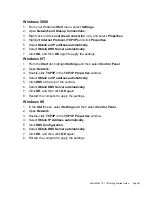
Page 24
Glossary of Networking Terms
Default Gateway
- A device on an Internetwork that forwards packets to another
network.
DHCP
- Dynamic Host Configuration Protocol allocates IP addresses to computers on
the network automatically without assigning a computer a static (fixed) IP address.
DNS
- A Domain Name System is a hierarchical naming system that resolves a domain
name with its associated IP address. A DNS server looks up the name of a computer
and finds the corresponding IP address. This allows users to access hosts using
friendly text-based names instead of IP addresses. These names are called fully
qualified domain names (FQDN).
IP Address
- An Internet Protocol Address is a 32 bit number that identifies a computer
or other resource on the Internet or on any TCP/IP network. The number is usually
expressed as four numbers from 0 to 255 separated by periods, for example,
172.16.31.254.
ISP
- An Internet Service Provider is the company that provides a connection to the
Internet.
LAN
- A Local Area Network is typically a group of computers located at a single
location, and is commonly based on the Ethernet architecture.
NAT
- Network Address Translation is an Internet standard that allows your local network
to use private IP addresses, which are not recognized on the Internet. The IP
address used for the router is the only routable IP address. The computers behind
the NAT can access the Internet through the router, but Internet users cannot access
the computers behind the router.
Packet
- A unit of information transmitted over the Internet or within any TCP/IP network.
Packets have a header, which contains information about the source, destination,
and protocol to be used for the data, and a body, which contains the data being
transmitted.
PPPoE
- The Point to Point Protocol over Ethernet supports the transmission of network
packets over an analog phone line.
Private IP Address
- An IP address for a resource in your network that is not known or
published outside the zone (for example LAN) where it is located.
Public IP Address
- An IP address for a resource in your network that is published
outside your network to the WAN.
Router
- A device that routes data between networks through IP address information in
the header of the IP packet. A router forwards packets to other routers until the
packets reach their destination. The Internet is the largest example of a routed
network.
Subnet
- A portion of a network. Each subnet within a network shares a common
network address and is uniquely identified by a subnetwork number.































